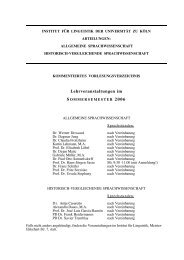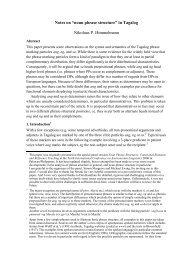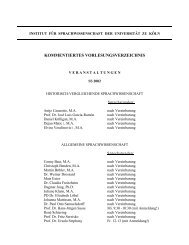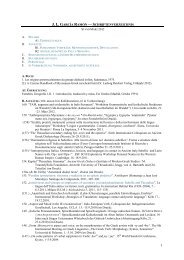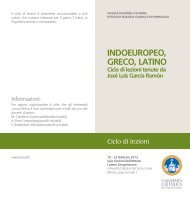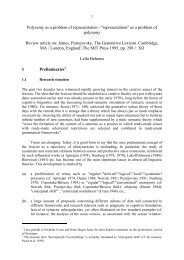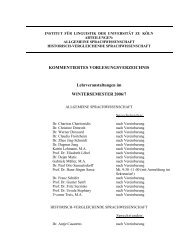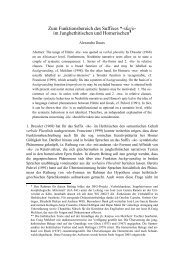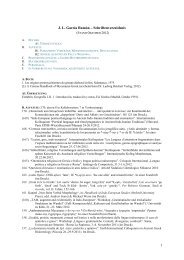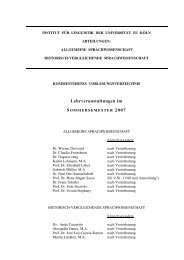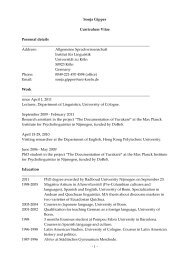Topics in Anatolian Historical Grammar Prof. Dr. H. Craig Melchert
Topics in Anatolian Historical Grammar Prof. Dr. H. Craig Melchert
Topics in Anatolian Historical Grammar Prof. Dr. H. Craig Melchert
You also want an ePaper? Increase the reach of your titles
YUMPU automatically turns print PDFs into web optimized ePapers that Google loves.
6<br />
po<strong>in</strong>ts out that factitives <strong>in</strong> *-eh 2 (phonetically *[aħ]) appear as Hittite ḫi-verbs with Pres3Sg<br />
-aḫḫi, never show<strong>in</strong>g lenition of *h 2 <strong>in</strong> direct contrast to nāḫi ‘affrights’ and šāḫi ‘fills up,<br />
clogs’, which by any analysis must cont<strong>in</strong>ue o-grade *nóh 2 ei and *sóh 2 ei. This strik<strong>in</strong>g<br />
difference cannot be co<strong>in</strong>cidental, and I see no way to avoid conclud<strong>in</strong>g that accented short *ó<br />
did <strong>in</strong> fact “lenite” a follow<strong>in</strong>g *h 2 . Such a restricted “lenition” of just *h 2 after accented short *ó<br />
was <strong>in</strong> fact proposed by Kimball (1999: 397). She made no explicit contrast with -aḫḫi < *-éh 2 ei<br />
<strong>in</strong> the factitives, nor did she try to motivate the change phonetically, and <strong>in</strong> <strong>Melchert</strong> (2011: 128)<br />
I dimissed the claim as ad hoc. The direct contrast cited by Kloekhorst between unlenited -aḫḫi<br />
< *-éh 2 ei vs. lenited -āḫi < -óh 2 ei compels a reconsideration.<br />
Before turn<strong>in</strong>g to the phonetic motivation for the change, I must deal with the putative<br />
counterexample I cited (2011: 128): Hitt. lāḫḫa- ‘campaign’, which appears to be an action noun<br />
of the τόμος-type reflect<strong>in</strong>g a preform *lóh 2 o-. Kloekhorst (2008: 510-11) argues for an orig<strong>in</strong>al<br />
root noun <strong>in</strong>stead, which would avoid the problem, s<strong>in</strong>ce an ablaut<strong>in</strong>g paradigm *lóh 2 -/léh 2 -<br />
could have generalized unlenited -ḫḫ- from the regular weak stem laḫḫ- < *léh 2 -. Unfortunately,<br />
Kloekhorst’s argument <strong>in</strong> favor of a root noun is not entirely compell<strong>in</strong>g: namely, that the<br />
denom<strong>in</strong>ative verb laḫḫiya- ‘to campaign’ can hardly be derived from an a-stem. However, as I<br />
argued <strong>in</strong> <strong>Melchert</strong> (2004: 376), Hieroglyphic Luvian hasi(ya)- means ‘to satiate’ (with reflexive<br />
particle ‘to satiate oneself, enjoy to the fullest’), derived from the noun (LINGERE)hasa-<br />
‘satiety, abundance’ (itself formed from the root seen <strong>in</strong> Palaic ḫaš- ‘be satiated’). 4 So we cannot<br />
4 This <strong>in</strong>terpretation is now supported by an occurrence <strong>in</strong> Hittite context, KBo 20.107+ iii 22,<br />
where we f<strong>in</strong>d the figura etymologica ḫāšiyamiš ḫāšiya ‘As a satiated one, satiate!’ (for the text<br />
see Bawanypeck 2005: 112). Just how this derivational pattern came about is a separate issue.<br />
One possibility is the existence <strong>in</strong> at least one case of an <strong>in</strong>terven<strong>in</strong>g adjective <strong>in</strong> *-iyo-, which



